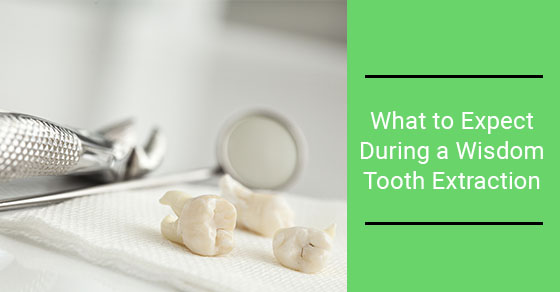Blog

What to Expect During a Wisdom Tooth Extraction
Posted by Dr. Julie Boudreault On 9-10-2019
Going to the dentist can be a nerve-wracking experience, especially when a visit involves a complex procedure. In particular, wisdom tooth extraction is a common dental surgery that thousands of Canadians undergo every year.
Even though we probably all know someone who still sports a killer smile without their third molars, it’s natural to be curious — and a little nervous — about extraction before going for the procedure ourselves. To address some common concerns, we’ve outlined a brief guide on what to expect during a wisdom tooth extraction.
1. Preparation
If your initial consultation with a dentist signifies the identification of an infected wisdom tooth, you might be prescribed a round of antibiotics. You’ll be instructed to take them for a certain number of days, depending on the infection’s severity, after which you can come back into the dentist’s office to have one or more of your third molars removed. It’s not uncommon for your extraction to be performed by someone other than your regular dentist, as wisdom tooth extraction is a specialized procedure.
2. Anesthesia
Before the actual extraction, your dentist will start by giving you a local anesthetic. The anesthetic will numb the gums surrounding the extraction area. Don’t panic if you also feel this numbness spread to other areas of your mouth, such as your lips and tongue, as this is common. Depending on the state of a tooth — such as whether it has fully ruptured or not — and how many you are getting extracted, your dentist will give you multiple injections. If you indicate that you can still feel your mouth sensation during the start of the actual procedure, your dentist may decide to perform another anesthetic injection.
If several or all four teeth are removed at once, or if you are anxious about the procedure and request it, you may opt for a general anesthetic or another form of sedation instead. General anesthetics work by preventing pain throughout the entire body and will cause you to sleep throughout the surgery, whereas you will remain awake under local anesthetics.
As general anesthetics have a stronger effect, your dentist may instruct you to avoid eating or drinking the night prior to your procedure.
3. Extraction
The method of extraction can generally be divided into two categories: simple and surgical. In simple extractions — typically only requiring a local anesthetic — the dentist will open up the gum tissue surrounding the tooth and separate connecting tissue between the tooth and the underlying bone.
Sometimes the tooth may be divided into smaller pieces so that individual sections can be removed. The tooth is loosened, and forceps are then applied to “pop” the tooth out. As scary as this may sound, you can rest assured that the numbing effects of the anesthesia will result in more of a tugging sensation than any actual pain.
In surgical extractions, sedation is used. An incision is made in the gums and, in some cases, the bone surrounding the tooth may also need to be cut out. Since sedation is involved in surgical extractions, you’ll be happy to know that you won’t feel a thing and will wake up with the extraction already taken care of.
Directly after the extraction process, you’ll be instructed to bite down on pieces of sterile gauze placed in between the extraction site to stem the flow of any blood. Usually, after around 30 minutes, the gauze can be removed and swapped out with new pieces; the dentist often provides you with extra gauze to take home.
4. Aftercare
Directly after the extraction process, you’ll be instructed to bite down on pieces of sterile gauze placed in between the extraction site to stem the flow of any blood. Usually, after around 30 minutes, the gauze can be removed and swapped out with new pieces; the dentist usually provides you with extra gauze to take home.
If there is intermittent bleeding after you’ve removed the first set of gauze, replacing the gauze in shorter intervals is recommended. The numbness will gradually wear off. In cases where you’ve had your lower wisdom teeth removed, the numbness may even last for up to 12 hours along your chin, lower lip, and teeth.
In extremely rare cases, a nerve may have been struck during the extraction, resulting in a more long-term numbness; but this is a worst-case scenario experienced by only a small percentage of patients.
For the first couple of hours following the extraction, you’ll be instructed to avoid eating or unnecessarily talking. If you have gauze in, this may be difficult anyway.
You’ll be given a post-procedure sheet by your dentist outlining ‘dos and don’ts’ for the next week. Gums tend to heal very quickly given the right conditions. Spitting and the use of straws when the wound sites are still raw can impede the formation of blood clots; without these, you can develop dry sockets, which is a painful condition that will require further trips to the dentist.
Extremely cold and hot foods should be avoided too, and sticking to a mostly liquid diet for the first few days will help you heal faster. If you started a round of antibiotics before the extraction due to an infection, you would need to finish off the prescription.
5. Follow-up
Your dentist may ask you to schedule a check-up in the week or so following an extraction to ensure that everything is healing well. Going back to your dentist is especially important if you have stitches that will need to be removed or experience any symptoms related to dry sockets.
To learn more about what to expect during a wisdom tooth extraction, call Milltown Dental at 905-878-8528 or contact us here.

